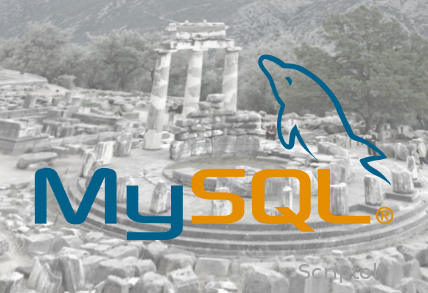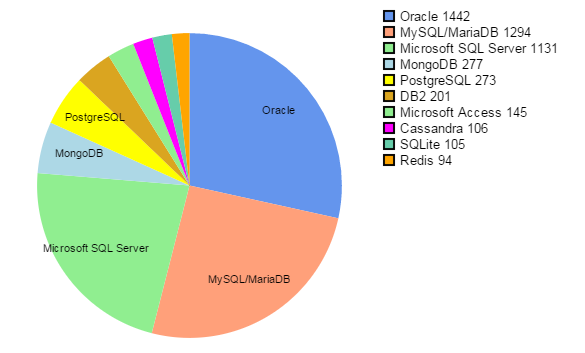MySQL or MariaDB
?The most popular of the relational database managers is installed on millions of servers. These include Youtube, Flickr, Yahoo!, Facebook (along with Hadoop), Twitter.
MySQL is used for both very large sites and small databases. The Tumblr site supports 60 billion rows for MySQL, which requires 200 dedicated competitor servers and a special tool, Jetpants, but it can be used for a simple two-column table.

MySQL was created in 1995 by David Axmark, Allan Larsson and Michael Wiedenius, who founded MySQL AB to market it.
In June 2000, he received a GPL license, but retained a dual license, you can choose a paid license, including for integration with other programs that are incompatible with the GPL .
The company was acquired by Sun on February 26, 2008. When it itself was acquired by Oracle on April 20, 2009, MySQL had a new owner (and concerned users, see below).
The popularity of MySQL has been declining since 2012, as the software is usually replaced by MariaDB (the same author), more high-performance and with more reactive service persons.
The creator gave the software the name of his second daughter Maria, while MySQL comes from My, which is the first (this is the source of confusion, due to which many products wanted to imitate MySQL, giving themselves the prefix My, which means "mine" in English).
In May 2017, the European Commission unblocked 25 million euros for the development and promotion of MariaDB. This will allow him to expand the team and accelerate its development.
Reading-oriented design
MySQL is optimized for reading, it is suitable for the Web, where browsing occurs more often than creating or changing pages.
It supports parallel queries of multiple users (unlike, for example, SQLite, which executes only one query at a time).
It is compatible with SQL2 and procedural PL/SQL since version 5.
MySQL is often used in conjunction with MemCached, a program that stores a database in memory to speed up transactions. It is used by such large sites as Facebook, Twitter. It is available for Wordpress, Joomla, Drupal.
The system can use various storage mechanisms, the role of which is to control the creation and deletion of data from the database, as well as the corresponding storage in the file system:
- MyISAM. Default source motor.
- InnoDB. The more powerful, bought by Oracle in October 2005, became the default engine, with version 5.5.
- BerkeleyDB. It was purchased by Oracle in February 2006, outdated with MySQL 5.1. And
- many others.
MySQL Cluster is a multi-server version. It distributes the load, which allows you to work in real time without waiting and failures. In doing so, the NDB engine is used in addition to one of the traditional engines above. The 7.2GA version can handle a billion transactions per minute. It is open source, only support is paid.
However, you need to know that if MySQL Cluster is provided by Oracle for free (on its servers), then this is not the case when the traffic becomes too much, and Oracle offers a paid solution.
Most programming languages can be used to use SGDB, therefore, to execute queries. The most commonly used languages are PHP and Java.
M from MySQL gives a letter to LAMP (Linux Apache MySQL PHP), a very popular site server system.
MySQL or MariaDB
?After Sun's purchase by Oracle, a database publisher that finds a free product in MySQL competing with its other paid products, what could be the future of MySQL? Delphic?
Oracle is trying to monetize software that tends to replace its main product, Oracle Database, with add-ons that cost between $2,000 and $10,000 per computer.
MySQL creator Michael Wiedenius gives his opinion: MySQL creators are no longer at Sun. His project is Fedora for MySQL, an independent project free from any business attaché.
As MySQL tends to become increasingly commercial, alternative solutions will eventually replace it. At $2,000 per server per year, this may become mandatory. Oracle seems unwittingly to be encouraging this trend by taking the first step: tests that test software are no longer provided.
MariaDB is a distribution that usually takes the place of MySQL, and it also comes from MySQL creator Michael Wiedenius. Based on MySQL 5.1, it is faster, uses XtraDB or InnoDB and adds features that Oracle provides only on the commercial version of MySQL.
Further, this distribution develops over time. For example, version 10 allows you to view data in the Cassandra database or through ODBC.
Wikipedia migrated from MySQL to MariaDB in 2013 and so do Linux distributions (Fedora in version 19, Suse on 12.3, Slackware on 14.1, Arch Linux on 2013.03), Red Hat on 7. Google uses (on thousands of servers) MariaDB and even participates in its development.
See the list of differences between MariaDB and MySQL (English). Note that with each new version there are even more differences. And, despite the differences, you can immediately install MariaDB as a replacement for MySQL, without changes in the databases. Under Linux, just one command.
However, MySQL continues to evolve, and version 5.7.7 implements JSON object storage in binary format for fast access. MySQL is not buried.
Market share
In May 2015. These figures (the number of positions) are given by the DB-Engine website, which relies on many criteria: links to the media, job offers, research in engines,....

Diagram by .fr
Oracle and Microsoft SQL Server are down sharply from May 2014. MySQL drops slightly. Others are on the rise. Startups often choose Postgre.
Alternatives to MySQL
In addition to MariDB, several more forks have been created that try to maintain compatibility:
- Drizzle. Lightweight version for cloud technologies. A derivative of MySQL 6.0 that was in development.
- Percona Server. Uses the XtraDB storage mechanism.
- Our Delta. MySQL set.
- WebScaleSQL is a joint open source project of Facebook, Google, Twitter and other companies for the MySQL version, which can support important databases and a very large number of connections. Of course, Oracle is not one of the authors, although it owns MySQL .
PostgreSQL is also seen as an open source alternative. But the software is not quite in the same category, it is more difficult to install and is designed specifically for large databases, where writing occurs as often as reading. Rather, it is an alternative to Oracle.
Uber migrated from PostgreSQL to Percona (fork by MySQL) plus Shemaless, which turns the database into NoSQL. This choice depends on their type of activity. They saw acceleration in frequent line updates. For clarity, Uber migrated from MySQL to PostgreSQL in 2013, and then with the introduction of Schemaless returned to MySQL.
By the way, MemSQL wants tomorrow's DBMS. It runs entirely in memory, accessing the disk at intervals to back up the data that needs to be saved, and thus it is 30 times faster than MySQL. True, you can load it into memory and the MySQL database, the difference is how the data is periodically saved to disk.
But these numbers are disputed, claiming that benchmarks are made on the default configuration and MySQL can be configured to make it faster, and that resiliency is disabled to achieve this speed. Two more software also work: Hana from SAP and VoltDB.
And then there is NoSQL - a set of different constructs: key-value pairs, graphs, documents. NoSQL is often seen as a solution for companies whose databases are becoming gigantic, but companies like Yahoo! and Twitter demonstrated that MySQL in a cluster (in a personal version) could support very large databases. In addition, other programs can be associated with MySQL to manage different structures: See Company databases on the Internet.
Downloads
- MySQL. Download one of the software versions.
- phpMyAdmin. Interface for online database management. This can also be done from FreeOffice.
- HeidiSQL. Works locally and can manage a remote database. (Windows).
- Jetpants. Tools for managing very large databases.